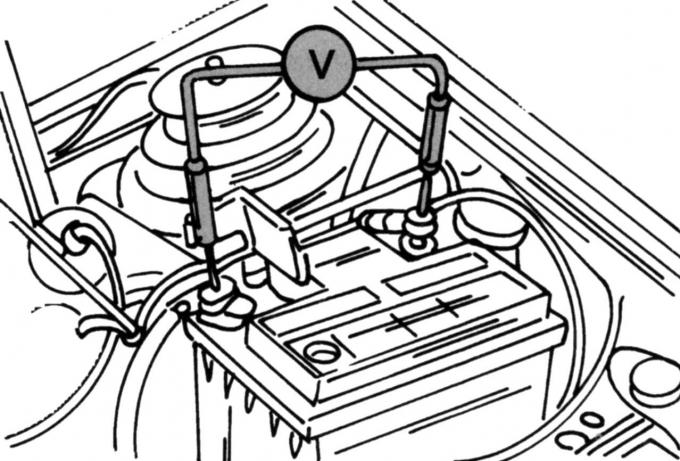The battery is either closed with a lid or has a transparent case. Since electrolyte components may evaporate, check the electrolyte level and top up with distilled water if necessary. The electrolyte level must be between the marks on the body or above the separating plates. To top up, remove the cap and fill with distilled water to the correct level.
Checking the degree of discharge of the battery

Pic. 281. Hydrometer for determining the density of electrolyte
The degree of discharge of the battery is determined by the density of the electrolyte, for this you need a hydrometer (pic. 281) with a pipette. Remove the cap and immerse the end of the hydrometer in the electrolyte. By pressing the rubber bulb, collect enough electrolyte so that the float can float freely. Depending on the degree of discharge, the electrolyte has a different density, which, in turn, determines the degree of immersion of the float and thus the corresponding reading on the scale printed on the float. At a value of 1.28 g/cm3 the battery is considered to be fully charged; at a value of 1.12 g / cm3 - completely discharged. The values in the interval between them determine the degree of rarefaction.

Pic. 282. Checking battery voltage with a voltmeter
To check the battery voltage, use a conventional voltmeter, which, as shown in fig. 282 is connected between two terminals. Check the voltage after the battery has been charged by the alternator for at least 6 hours. The voltmeter reading should be 12.4 V. A lower value indicates poor battery charging.
Charging the battery
Only add distilled water to a heavily discharged battery and only after charging. While the battery is being charged, the acid level rises and the battery may «boil over». The charging current should not exceed 10% of the battery capacity at first. Depending on the design of the charger used, the charging current is gradually reduced automatically. The battery is considered fully charged if the density of the electrolyte does not change during 2 hours of charging.
Remove the battery cover and leave it on the air vent. Since splashing of acid cannot be avoided when charging strongly, place sheets of newspaper around the battery, for example. If charging is carried out indoors, it must be well ventilated. Never light a battery with an open flame.
When using a charger with automatic shutdown, you can leave the battery in the car. It is also possible not to disconnect the terminals. When using a fast charger, disconnect both battery terminals to avoid overloading alternator diodes, switching electronics, car radio, etc.
Removal and installation
The battery is located in the engine compartment on the body frame. Before removal, disconnect the wires from the battery terminals. Always disconnects first «negative» the wire. Then remove the terminal bolts and remove the battery.
Before installation, first clean the terminals and lubricate them with an appropriate lubricant. Then first connect and tighten «positive» the wire.
Starting the engine with a discharged battery
The easiest option is to use the wire connecting the starter and the battery «donor». This wire must be properly sized and have strong connection terminals to carry current from one battery to the other. Connect the positive wire to both positive terminals first, then the negative wire to the corresponding terminals.
Pushing and towing are also the most common ways to start an engine when «weak» battery.
When starting the engine by pushing, proceed as follows:
- turn on the ignition;
- engage 1st gear (engaging 2nd gear would cause the alternator to run too slowly to get good current);
- depress the clutch, push the car until a good speed is reached;
- quickly depress the clutch pedal, as a result of which the crankshaft of the engine should turn and the engine will start to work;
- Immediately depress the clutch again and press the accelerator pedal.
Starting the engine by towing has its drawbacks, because due to lack of experience it can lead to big troubles. Therefore, remember that when the engine is not running, the power brake booster and steering do not work. Also consider the above remark regarding the catalytic converter. Therefore, specific instructions for towing are not given.
Visitor comments